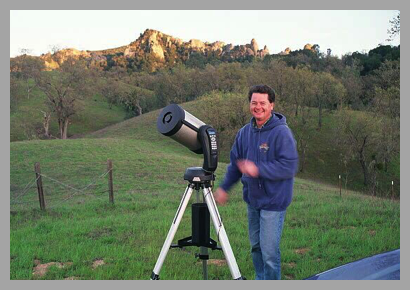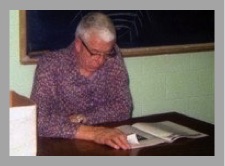About Me
Left: My Celestron Nexstar 8 telescope and me
Below: Dr. E.G. Ebbighausen, Professor Emeritus of Astronomy, University of Oregon

I've been interested in astronomy since I was a kid. I spent many hours scrutinizing descriptions of telescopes, pier mounts, eyepieces, etc. in the Edmund Scientific catalog. Even then, I determined that an 8 inch telescope would be the ideal size for light gathering power and portability. However, good telescopes were beyond my budget.
Dr E.G.Ebbighausen
While I was attending the University of Oregon I took a memorable Astronomy course taught by Professor Emeritus, E.G. Ebbighausen ("Ebbie", as his students referred to him when he wasn't within earshot). The photo in the upper right of this page is Dr. Ebbighausen.
Dr. Ebbighausen's class was one of the most enjoyable in my college career. He would lecture on the orbits of planets and the structure of stars but he would also season his lectures with discussions on such topics as the plasticity of glass and of witnessing the breakup of winter ice on the headwaters of the Mississippi River when he was a child in Minnesota. I still savor the memory of his winding lectures. His out-of-print textbook on Astronomy remains one of the most concise and useful astronomical references in my library.
One story Dr Ebbighausen recounted was of his days working on his PhD at the University of Chigago in the 1930’s. He was assigned to perform an observing program on the University’s 40 inch telescope and finished the primary observing program in the early morning hours. Upon noting that the early morning skies provided exceptional clarity, student Ebbighausen turned the 40 inch telescope on Mars at close opposition. He said that the seeing was perfect at over 1000x and, much to his surprise, he saw craters. The director of the observatory walked in a short time later and told student Ebbighausen that if he was every caught dallying again, he would be summarily kicked out of the school. To quote the director of the observatory, “When the primary observing program was concluded, the secondary observing program was to be commenced immediately!”, declared the director. Some years later when the first images of Mars taken by a spacecraft showed craters, Dr. Ebbighausen was particularly pleased.
Another story was recounted by a graduate student who was taking a course on eclipsing binary stars. The professor teaching the course showed the class a light curve that was considered to be one of the best, most accurate photoelectric light curves ever constructed up to that time (mid 1970’s). All of the graduate students assumed that the observer (Dr. Ebbighausen) used state-of-the-art equipment and the latest in computers to obtain and reduce the data. Some time after that, the professor showed the class some photos of the telescope Dr Ebbighausen used to collect his data: An 8-inch refractor telescope whose paint was peeling off and which was balanced by a basketball-sized rock tied to the telescope with a rope! The lesson learned that day was that it is the care and competence of the craftsman which produces a masterpiece, not the tools with which he works.
When I graduated from college, I began working as a software engineer for Tektronix and could finally afford a good telescope, Sadly, I was living in Western Oregon, where frequent clouds made stargazing less compelling. In 2000 our family moved to an area of the US where the overhead sky is clear and dry most of the year. At the same time Celestron introduced their NexStar 8 computerized telescope. This telescope seemed ideal for me; I had to have one! The photo at the top of this page is me with that telescope at a Central Coast Astronomical Society star party.
Most of the astro photos on this site were taken from our back deck in California with the Celestron NexStar-8.
